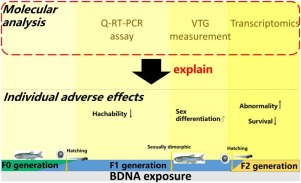当前位置:
X-MOL 学术
›
Aquat. Toxicol.
›
论文详情
Our official English website, www.x-mol.net, welcomes your
feedback! (Note: you will need to create a separate account there.)
Underlying mechanisms of reproductive toxicity caused by multigenerational exposure of 2, bromo-4, 6-dinitroaniline (BDNA) to Zebrafish (Danio rerio) at environmental relevant levels.
Aquatic Toxicology ( IF 4.1 ) Pub Date : 2019-09-12 , DOI: 10.1016/j.aquatox.2019.105285 Xianyi Xie 1 , Yaru Jin 1 , Zhiyuan Ma 1 , Song Tang 2 , Hui Peng 3 , John P Giesy 4 , Hongling Liu 1
Aquatic Toxicology ( IF 4.1 ) Pub Date : 2019-09-12 , DOI: 10.1016/j.aquatox.2019.105285 Xianyi Xie 1 , Yaru Jin 1 , Zhiyuan Ma 1 , Song Tang 2 , Hui Peng 3 , John P Giesy 4 , Hongling Liu 1
Affiliation

|
2-bromo-4, 6-dinitroaniline (BDNA) is a mutagenic aromatic amine involved in the production and degradation of Disperse blue 79, one of the most extensively used brominated azo dyes. In our previous study, a multigenerational exposure of BDNA (0.5, 5, 50 and 500 μg/L) to zebrafish from F0 adult to F2 larvae including a recovery group in F2 larvae was conducted. The effects on apical points observed in individuals and the long-term effects predicted on population were all related to reproduction. In this study, we performed molecular analysis to elucidate the underlying mechanisms of the reproductive toxicity of BDNA. In F1 generation, measurement of vitellogenin and transcription levels of genes associated with hypothalamus-pituitary-gland (HPG) axis, estrogen receptor (ER) and androgen receptor (AR) were conducted. There was a decrease in VTG level in the blood of F1 female fish and transcription of genes related to ER was more affected than that of genes related to AR. These results were consistent with adverse effects that sexual differentiation was biased towards males and fecundity was impaired in a concentration-dependent manner in adults of F1 generation after 150 days exposure. In F2 generation, global gene transcriptions of F2 larvae were investigated. It was uncovered that processes related to apoptosis, development and DNA damage were strongly affected. Alterations to these biological pathways accounted for the irreversible parental influence on a significant decrease in hatchability and increase in abnormality of F2 larvae. All evidence suggested that the multigenerational exposure of BDNA posed lasting effects transmitted from parents to offspring that persisted after exposure ceased.
中文翻译:

在环境相关水平下,由2代溴4、6-二硝基苯胺(BDNA)多代暴露于斑马鱼(Danio rerio)引起的生殖毒性的基本机制。
2-bromo-4,6-dinitroaniline(BDNA)是一种致突变的芳族胺,与Disperse blue 79的生产和降解有关,Disperse blue 79是最广泛使用的溴化偶氮染料之一。在我们之前的研究中,从F0成虫到F2幼虫,包括F2幼虫的恢复组,对斑马鱼进行了多代BDNA(0.5、5、50和500μg/ L)暴露。在个体中观察到的对根尖的影响以及对种群预测的长期影响均与生殖有关。在这项研究中,我们进行了分子分析,以阐明BDNA生殖毒性的潜在机制。在F1代中,进行了卵黄蛋白原的测定以及与下丘脑-垂体-腺体(HPG)轴,雌激素受体(ER)和雄激素受体(AR)相关的基因的转录水平。F1雌性鱼类血液中的VTG含量降低,与ER相关的基因的转录比与AR相关的基因受到的影响更大。这些结果与不良反应一致,即在暴露150天后,F1代成年成年人的性别分化偏向男性,而生殖力以浓度依赖的方式受到损害。在F2代中,研究了F2幼虫的整体基因转录。发现与凋亡,发育和DNA损伤有关的过程受到强烈影响。这些生物学途径的改变解释了不可逆的父母影响,即孵化率的显着降低和F2幼虫异常的增加。
更新日期:2019-09-12
中文翻译:

在环境相关水平下,由2代溴4、6-二硝基苯胺(BDNA)多代暴露于斑马鱼(Danio rerio)引起的生殖毒性的基本机制。
2-bromo-4,6-dinitroaniline(BDNA)是一种致突变的芳族胺,与Disperse blue 79的生产和降解有关,Disperse blue 79是最广泛使用的溴化偶氮染料之一。在我们之前的研究中,从F0成虫到F2幼虫,包括F2幼虫的恢复组,对斑马鱼进行了多代BDNA(0.5、5、50和500μg/ L)暴露。在个体中观察到的对根尖的影响以及对种群预测的长期影响均与生殖有关。在这项研究中,我们进行了分子分析,以阐明BDNA生殖毒性的潜在机制。在F1代中,进行了卵黄蛋白原的测定以及与下丘脑-垂体-腺体(HPG)轴,雌激素受体(ER)和雄激素受体(AR)相关的基因的转录水平。F1雌性鱼类血液中的VTG含量降低,与ER相关的基因的转录比与AR相关的基因受到的影响更大。这些结果与不良反应一致,即在暴露150天后,F1代成年成年人的性别分化偏向男性,而生殖力以浓度依赖的方式受到损害。在F2代中,研究了F2幼虫的整体基因转录。发现与凋亡,发育和DNA损伤有关的过程受到强烈影响。这些生物学途径的改变解释了不可逆的父母影响,即孵化率的显着降低和F2幼虫异常的增加。































 京公网安备 11010802027423号
京公网安备 11010802027423号